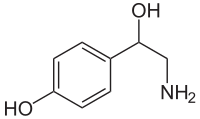Trace amines
| Trace amines (arylethylamines) |
|---|
 Phenethylamine |
 Tyramine |
 Octopamine |
 Tryptamine |
Trace amine (engl. Trace Amines ) are biogenic amines , by decarboxylation of aromatic amino acids, arise. According to their name, they are only found in small quantities in the body.
discovery
It was originally believed to be a by-product of the synthesis of the neurotransmitters dopamine , serotonin, and norepinephrine . By chance, however, in 2001 Beth Borowsky discovered a new family of receptors that were specifically stimulated by trace amines. She baptized these receptors TA1, TA3, TA4 and TA5. Other types of receptors were found in mice and rats .
meaning
Trace amine gained attention through further work because the receptors in the reward system of the brain called the nucleus accumbens expressed are. Many of our foods contain trace amines, for example cheese and bananas contain tyramine. β-Phenylethylamine (PEA) and tryptamine are found in chocolate. Since the discovery of the receptors, in addition to serotonin and theobromine, they have had a psychologically brightening effect ( chocolate: the feel-good-food ). Dysregulation in the human body has been linked to schizophrenia and depression and is believed to be possible. a. a role in migraines , Parkinson's disease, and ADHD .
The trace amines include:
- β-phenylethylamine , also structurally related to dopamine
- Tyramine, structurally related to dopamine
- Octopamine, structurally related to noradrenaline
- Tryptamine, structurally related to serotonin
( R ) -4-Hydroxyamphetamine is one of the most potent agonists currently known on the trace amine receptor, type TA1.
swell
- ↑ L. Lindemann, MC Hoener (2005): A renaissance in trace amines inspired by a novel GPCR family , TIPS, Vol. 26, No. 5.
- ↑ JR Bunzow et al. (2001): Mol. Pharmacol. Vol. 60 (6), pp. 1181-88 .
literature
- Trace amines: Identification of a family of mammalian G-protein-coupled receptors (GPCR) , Beth Borowsky et al., Christophe Gerald, Synaptic Pharmaceutical Corporation, Paramus, NJ, PNAS, June 2001, vol. 98
- Phenylethylamine and phenylacetic acid in CSF of schizophrenics and healthy controls , Beckmann H, Reynolds GP, Sandler M, Waldmeier P, Lauber J, Riederer P, Gattaz WF.
- Brain cannabinoids in chocolate , Emmanuelle di Tomaso, Massimiliano Beltramo, Daniele Piomelli, Description: SIR - Chocolate craving, common in western societies, is still incompletely, Nature 382, 677–678 (22 Aug 1996) Scientific Correspondence (from the Nature Archive: January 1987 - December 1996)